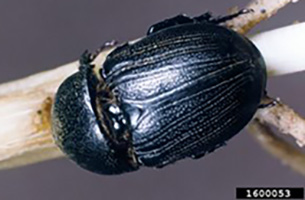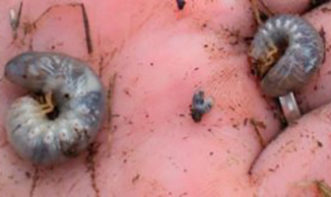The sugarcane beetle, Euetheola humilis, is a sporadic but serious pest of corn in the southeastern United States.1,2 It was previously known as the rough-headed corn stalk-beetle and was first identified in rice fields in Louisiana. It has been documented as a pest of several crops, including sugarcane, rice, strawberry, tobacco, roses, turfgrass, cotton, and corn.3 A significant outbreak and resulting damage to corn was first identified in the tidewater region of Virginia in 1914.4 The purpose of this article is to provide background information on the sugarcane beetle, describe the injury to corn, and discuss management strategies.
Identification
Adults vary in size from 0.5 in to 0.6 in. They are stout, matte black, dome-shaped beetles (figure 1). The elytra (wing covers) have double rows of puncture-like markings down the length.5 The front legs are thickened and have four tooth-like projections used for digging. The larvae of the sugarcane beetle are white grubs with a red head capsule and yellowish legs (figure 2). Larvae reach up to 1¼ in long.
Life Cycle
The sugarcane beetle completes a single generation each year. Adult beetles emerge in late summer and early fall and spend the majority of the fall underground, emerging on warm days during the fall to feed on grasses. The primary hosts of the sugarcane beetle are grassy weeds, but they will readily feed on corn in the absence of weed hosts. Adult beetles begin a period of hibernation when temperatures fall in the winter. Adults burrow deeper into the soil during the winter when the temperature drops below 50°F.6 Adult beetles reemerge in late March or early April and begin to feed. Mating and subsequent oviposition occur in late May to June. Each female sugarcane beetle is capable of laying up to one hundred eggs over the course of several weeks.5
Injury to Corn
Adult beetles are responsible for damage to corn. They burrow into the soil and feed directly on the roots and the crown of seedling corn plants (figure 3). 3 They can also potentially bore into the stalk. Injured plants can have yellow stripes along the length of leaves after further growth, which can be confused with nutrient deficiency.2 Continued feeding will lead to wilting plants and, in severe cases, can cause plant death. Injury from feeding can be seen from emergence to V10; however, injury primarily occurs when feeding occurs from V3 to V5.2,6 Sugarcane beetle adults can continue feeding on corn until it reaches approximately four feet tall.

Figure 3. Left: Plants with sugarcane beetle damage displaying deadheart. Deadheart is death of the center leaves of the plant in the whorl. Right: Sugarcane beetle damaged plant. Image credit: Tara Smith, LSU AgCenter.
Management
Cultural Control
Scouting can aid in replant decisions if the damage is severe and inform future planting decisions. However, monitoring sugarcane beetle populations directly is challenging during vulnerable stages of corn development, as the beetles are concealed in the ground. Injured plants with suspected sugarcane beetle injury should be dug up to determine if adult beetles or below ground damage are present. Avoiding planting corn in previous pastures or other fields with established grasses can potentially reduce the population of beetles, as grassy environments readily support sugarcane beetle populations.2 Planting early can also help to avoid peak sugarcane beetle emergence. Conservation tillage has been associated with high densities of sugarcane beetles.7 Deep tillage may be used in fields with recurring sugarcane beetle infestations.7
Chemical Control
Chemical management of sugarcane beetle primarily relies on the use of preventative treatments. Once sugarcane beetle damage is identified, additional foliar applications are generally ineffective.8 Seed treatments, as well as in-furrow insecticide applications, can be effective for sugarcane beetle management.6,8–10 Terbufos (Counter 20G) applied in-furrow has been found to be effective.9 Seed treatments are also effective, with high rates of clothianidin (Poncho) providing the best control. Several production guides also recommend the combined use of a seed treatment and an in-furrow application for good to excellent control.6
Summary
The sugarcane beetle is a sporadic but potentially serious pest of corn in the southeastern United States. Cultural control in combination with preventative insecticide treatments can prevent serious damage.
References Cited
- Smith T, Leonard B, Hammond A, Gable R. Managing sugarcane beetles in field corn with seed treatments. Louisiana Agriculture. 2006 [accessed 2020 Apr 23]. https://www.lsuagcenter.com/portals/communications/publications/agmag/archive/2006/fall/managing-sugarcane-beetles-in-field-corn-with-seed-treatments.
- Gyawaly S, Laub C, Youngman R. Sugarcane beetle in corn. Virginia Cooperative Extension. 2018 [accessed 2020 Apr 23]. https://www.pubs.ext.vt.edu/content/dam/pubs_ext_vt_edu/ENTO/ENTO-13/ENTO-294.pdf.
- Baerg W. The rough-headed cornstalk beetle. In: Experiment Station Record, Volume 87. US Department of Agriculture; 1942. p. 252.
- Phillips WJ. The rough-headed corn stalk-beetle in the southern states and its control. U.S. Department of Agriculture; 1917.
- Phillips WJ, Fox H. The rough-headed corn stalk-beetle. U.S. Department of Agriculture; 1924.
- Smith TP, Beuzelin JM, Catchot AL, Murillo AC, Kerns DL. Biology, ecology, and management of the sugarcane beetle (Coleoptera: Scarabaeidae) in sweet potato and corn. Journal of Integrated Pest Management. 2015;6(1):1–6. doi:10.1093/jipm/pmv012.
- Musick GJ. Management of arthropod pests in conservation-tillage systems in the southeastern US. In: Proceedings of the 1985 Southern Region No-Till Conference. 1985. p. 193.
- Buntin D. A guide to corn production in Georgia. Georgia Cooperative Extension. 2019 [accessed 2020 Apr 24]:73,81. https://grains.caes.uga.edu/content/dam/caes-subsite/grains/docs/corn/2019-Corn-Production-Guide.pdf.
- Riley TJ. Greenhouse and field evaluations of granular soil insecticides for control of sugarcane beetle, Eutheola rugiceps (Coleoptera: Scarabaeidae) in field corn. The Florida Entomologist. 1986;69(2):390–394.
- Tindall KV, Gable R, Emfinger K, Leonard BR. Evaluation of selected insecticide treatments against soil insects in field corn, 2004. Arthropod Management Tests. 2005;30(1):F30. doi:10.1093/amt/30.1.F31.



